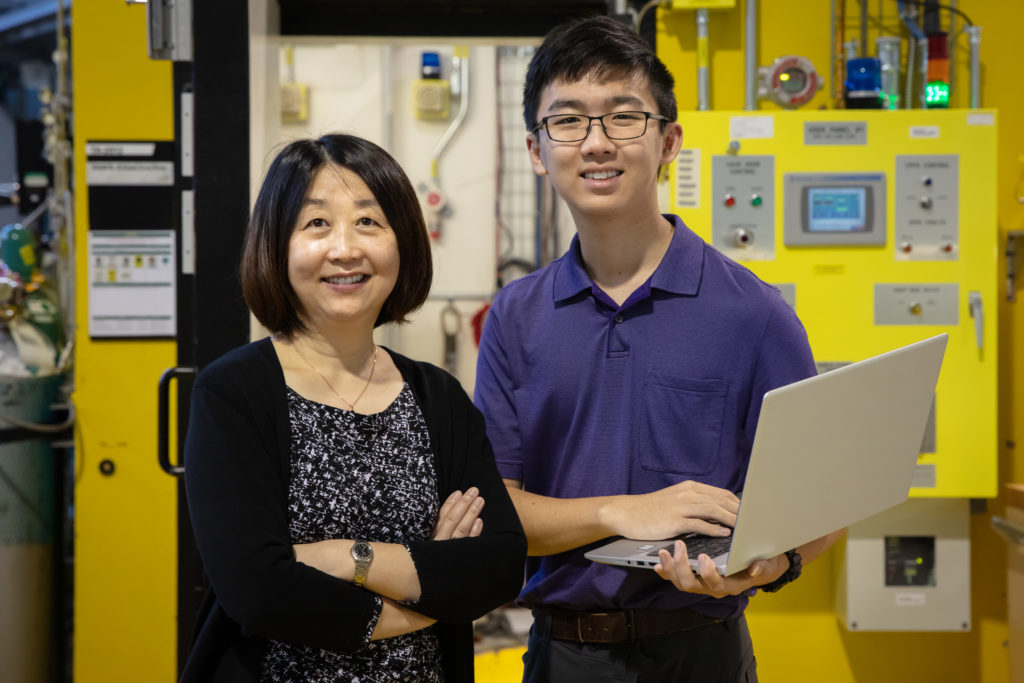Senior research scientist Ying Shi with Corning Incorporated is no exception. Her research focuses on understanding the structure–property correlation of glass to develop new compositions tailored for a range of applications. She frequently uses neutron scattering at the Department of Energy’s (DOE’s) Oak Ridge National Laboratory (ORNL) to gain insights into myriad glass samples at the atomic scale.
Understanding how the atomic structure of various types of glass correlates with their properties is important to many consumer electronics. For example, the cover glass used in personal electronics such as cell phones needs to be tough enough to resist cracking, while the glass panel on a flat screen TV needs to exhibit minimal dimensional changes to ensure high resolution as it undergoes heat treatments during the manufacturing process.
“It is an extremely tough and important problem to truly understand the atomic structure of silicate glasses and how their structures correlate with their properties,” Shi said. “We rely on large data sets to decipher the structure–property correlation.” That’s why every time Ying comes to ORNL’s Spallation Neutron Source to use the NOMAD instrument, she measures nearly 100 glass samples that have systematically varied compositions and different treatments.
Glass structure is different from crystalline materials. While the atoms in crystalline materials are arranged in an ordered way according to symmetry and periodicity—giving them what materials scientists call long-range order—glass has only short- and medium-range order.
“Medium-range order, the key structural parameter to determine glass properties, can be revealed by the first sharp diffraction peak of neutron total scattering,” Shi said.
Shi’s current experiments on the NOMAD instrument at ORNL’s Spallation Neutron Source (SNS) allow her to correlate medium-range-order structural data collected on her specimens with numerous properties including hardness and coefficient of thermal expansion.
What’s extra special about these experiments, she says, is that they incorporate code written by her teenage son. Shi’s son, Albert, who was an intern at Corning this past summer, was just 14 years old when he initially wrote the code for his mom’s data analysis.
Now 16, Albert says he had already been learning to code in C# with his dad when his mom found she was unable to hire a professional coder to treat her hundreds of data files because her project, in the exploratory phase, hadn’t budgeted for one.
“It might have taken a year for her to apply for the funding for professional coding, and she wanted to speed up the process and I wanted to help,” Albert explained. “The code basically processes the raw neutron beamline data and performs various mathematical treatments on the first sharp diffraction peak, which allows us to derive medium-range structural information within the glass.”
Shi adds that, before Albert developed the code, she had to treat each data file from her experiments with two commercially available software packages, but they couldn’t communicate with each other.
“I used to do some treatment myself and then manually output the data and then manually input it into the second software,” she said.
Each data file took a half-hour to analyze using this method, and she knew it wouldn’t be sustainable for hundreds of data files and impossible if she wanted to optimize the fitting parameters.
Shi says Albert’s code allows her to process 20 data files in less than 30 seconds, instead of taking a half-hour for 1 file, and she can tweak parameters more easily and get better results.
ORNL has agreed to host Albert’s code on its GitHub, an open-source software development platform, and RingFSDP, a novel method Shi developed from her son’s code, is now available to benefit the glass research community. She recently published a paper on RingFSDP.
“Hosting it on our repository here at ORNL makes it accessible to everyone. Hosting also makes sense because NOMAD team members were involved in the code’s development and are on the publication, and we host a lot of code developed either solely at ORNL or in collaboration with outside entities,” said neutron diffraction group leader Matthew Tucker.
Albert has continued to improve his original code, and he wrote two additional codes during his Corning internship that he plans to share with ORNL.
SNS is a DOE Office of Science User Facility. UT-Battelle LLC manages ORNL for DOE’s Office of Science. The Office of Science is the single largest supporter of basic research in the physical sciences in the United States and is working to address some of the most pressing challenges of our time. For more information, please visit https://energy.gov/science.—by Laurie Varma
Original post https://alertarticles.info




